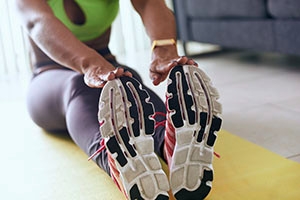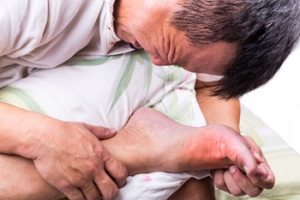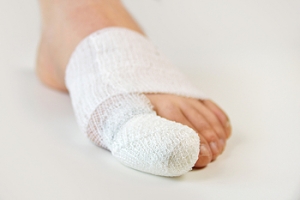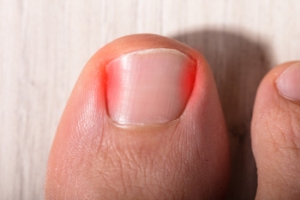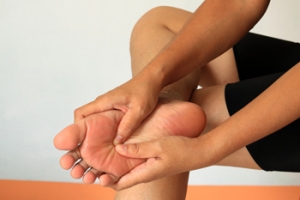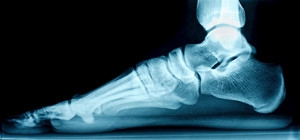Super User
What to Know About a Broken Toe
The forefoot is composed of five metatarsal bones and fourteen phalanges. Each toe has three phalanges except for the big toe which only has two. Our toes play an essential role to the walking process, which is why a broken toe could seriously disrupt one’s ability to move around. Toe fractures are common and can be very painful. Fortunately, these injuries rarely require surgery and usually heal with rest and a change in activity.
Broken toes typically result from a traumatic event such as falling, stubbing the toe, or dropping something on the toe. Traumatic toe fractures may be categorized as either minor or severe fractures. At times, one may hear a “pop” or “crack” sound when the bone breaks. Common symptoms of a traumatic toe fracture include pain, throbbing, bruising, swelling, and redness.
Another type of toe fractures is a stress fracture. These injuries usually appear in the form of small hairline breaks on the bone. Stress fractures develop after repetitive activity instead of a single injury. Stress fractures occur when the muscles in the bone become too weak to absorb impact. Consequently, the toe bone becomes vulnerable to any pressure and impact it endures. Symptoms for a stress fracture in the toe include swelling without bruising, tenderness to the touch, pain that goes away with rest, and pain after walking or running.
If you suspect that you have a broken toe, you should make an appointment with your podiatrist. He or she will likely diagnose you by performing a physical exam and an X-ray. Treatment for a broken toe may include the R.I.C.E. method, buddy taping, surgery, or antibiotics. The R.I.C.E. method (Rest, Ice, Compression, and Elevation) is a common treatment method for many injuries because it decreases pain. Buddy tapping involves wrapping the injured toe next to an adjacent toe to keep it supported and protected. These two methods have proven to be effective in the healing process for toe fractures. The estimated healing time for a broken toe is approximately four to six weeks. If the injury becomes infected or requires surgery, the estimated healing time may take eight weeks or more.
Possible Methods to Prevent Running Injuries
 People who enjoy the sport of running may experience chronic foot pain. This can be a result of a gradual stress fracture, or a sudden injury. Research has indicated it may help to perform proper stretching techniques for several minutes before beginning to run, as this can help to prevent running injuries. Range of motion in the legs can be improved by implementing foam rolling on the calves, which can help to increase blood flow to the soft tissue. Additionally, it is beneficial to choose the right running shoes that will provide adequate support, which can protect the body from excessive impact. Many runners understand the importance of slowly building mileage and speed, and this is typically helpful in preventing injuries. If you would like additional information about how to prevent running injuries, please speak with a podiatrist who can provide useful tips.
People who enjoy the sport of running may experience chronic foot pain. This can be a result of a gradual stress fracture, or a sudden injury. Research has indicated it may help to perform proper stretching techniques for several minutes before beginning to run, as this can help to prevent running injuries. Range of motion in the legs can be improved by implementing foam rolling on the calves, which can help to increase blood flow to the soft tissue. Additionally, it is beneficial to choose the right running shoes that will provide adequate support, which can protect the body from excessive impact. Many runners understand the importance of slowly building mileage and speed, and this is typically helpful in preventing injuries. If you would like additional information about how to prevent running injuries, please speak with a podiatrist who can provide useful tips.
All runners should take extra precaution when trying to avoid injury. If you have any concerns about your feet, contact Dr. John Branwell of Kearny, New Jersey. Our doctor will treat your foot and ankle needs.
How to Prevent Running Injuries
There are a lot of mistakes a runner can make prior to a workout that can induce injury. A lot of athletes tend to overstretch before running, instead of saving those workouts for a post-run routine. Deep lunges and hand-to-toe hamstring pulls should be performed after a workout instead of during a warmup. Another common mistake is jumping into an intense routine before your body is physically prepared for it. You should try to ease your way into long-distance running instead of forcing yourself to rush into it.
More Tips for Preventing Injury
- Incorporate Strength Training into Workouts - This will help improve the body’s overall athleticism
- Improve and Maintain Your Flexibility – Stretching everyday will help improve overall performance
- “Warm Up” Before Running and “Cool Down” Afterward – A warm up of 5-10 minutes helps get rid of lactic acid in the muscles and prevents delayed muscle soreness
- Cross-Training is Crucial
- Wear Proper Running Shoes
- Have a Formal Gait Analysis – Poor biomechanics can easily cause injury
If you have any questions, please feel free to contact our office located in Kearny, NJ . We offer the newest diagnostic and treatment technologies for all your foot care needs.
Gout is Arthritis
 Gout is a painful condition that typically affects the joints of the big toe. It occurs as a result of excess uric acid in the bloodstream, which can cause crystals to form in the joints. Gout is a form of arthritis, and the symptoms that are most associated with this ailment often include swelling and redness surrounding the affected joints, severe pain and discomfort, and the area may feel warm. There are specific foods that have elevated purine levels, and this is a contributing factor to the onset of gout. These consist of red meat, alcohol, and certain types of seafood. It is beneficial to have a proper diagnosis performed, and this is often accomplished by extracting a portion of fluid that contains the crystals. Incorporating healthy lifestyle changes may be helpful in preventing future gout attacks. If you have this painful condition, it is advised that you consult with a podiatrist who can properly treat this ailment.
Gout is a painful condition that typically affects the joints of the big toe. It occurs as a result of excess uric acid in the bloodstream, which can cause crystals to form in the joints. Gout is a form of arthritis, and the symptoms that are most associated with this ailment often include swelling and redness surrounding the affected joints, severe pain and discomfort, and the area may feel warm. There are specific foods that have elevated purine levels, and this is a contributing factor to the onset of gout. These consist of red meat, alcohol, and certain types of seafood. It is beneficial to have a proper diagnosis performed, and this is often accomplished by extracting a portion of fluid that contains the crystals. Incorporating healthy lifestyle changes may be helpful in preventing future gout attacks. If you have this painful condition, it is advised that you consult with a podiatrist who can properly treat this ailment.
Gout is a foot condition that requires certain treatment and care. If you are seeking treatment, contact Dr. John Branwell from Kearny, New Jersey. Our doctor will treat your foot and ankle needs.
What Is Gout?
Gout is a type of arthritis caused by a buildup of uric acid in the bloodstream. It often develops in the foot, especially the big toe area, although it can manifest in other parts of the body as well. Gout can make walking and standing very painful and is especially common in diabetics and the obese.
People typically get gout because of a poor diet. Genetic predisposition is also a factor. The children of parents who have had gout frequently have a chance of developing it themselves.
Gout can easily be identified by redness and inflammation of the big toe and the surrounding areas of the foot. Other symptoms include extreme fatigue, joint pain, and running high fevers. Sometimes corticosteroid drugs can be prescribed to treat gout, but the best way to combat this disease is to get more exercise and eat a better diet.
If you have any questions please feel free to contact our office located in Kearny, NJ . We offer the newest diagnostic and treatment technologies for all your foot and ankle needs.
What Is Buddy Taping?
 The first symptom many people experience if they have broken their toe is severe pain and discomfort. Other noticeable signs can include swelling, bruising on or around the affected toe, and difficulty walking. In severe fractures, patients may hear a popping sound as the break occurs. Common reasons for this type of injury to happen can include stepping unexpectedly off of a curb, hitting it against a piece of furniture, or it may gradually develop as a result of a stress fracture. Effective treatment options can include taping the affected toe to the toe next to it, which is referred to as buddy taping. This can be helpful in providing the necessary stability as the healing process occurs. Mild relief may be found when the foot is elevated, and this can be beneficial in reducing existing swelling. If you have broken your toe, it is suggested that you consult with a podiatrist who can suggest the proper treatment for you.
The first symptom many people experience if they have broken their toe is severe pain and discomfort. Other noticeable signs can include swelling, bruising on or around the affected toe, and difficulty walking. In severe fractures, patients may hear a popping sound as the break occurs. Common reasons for this type of injury to happen can include stepping unexpectedly off of a curb, hitting it against a piece of furniture, or it may gradually develop as a result of a stress fracture. Effective treatment options can include taping the affected toe to the toe next to it, which is referred to as buddy taping. This can be helpful in providing the necessary stability as the healing process occurs. Mild relief may be found when the foot is elevated, and this can be beneficial in reducing existing swelling. If you have broken your toe, it is suggested that you consult with a podiatrist who can suggest the proper treatment for you.
A broken toe can be very painful and lead to complications if not properly fixed. If you have any concerns about your feet, contact Dr. John Branwell from Kearny, New Jersey. Our doctor will treat your foot and ankle needs.
What to Know About a Broken Toe
Although most people try to avoid foot trauma such as banging, stubbing, or dropping heavy objects on their feet, the unfortunate fact is that it is a common occurrence. Given the fact that toes are positioned in front of the feet, they typically sustain the brunt of such trauma. When trauma occurs to a toe, the result can be a painful break (fracture).
Symptoms of a Broken Toe
- Throbbing pain
- Swelling
- Bruising on the skin and toenail
- The inability to move the toe
- Toe appears crooked or disfigured
- Tingling or numbness in the toe
Generally, it is best to stay off of the injured toe with the affected foot elevated.
Severe toe fractures may be treated with a splint, cast, and in some cases, minor surgery. Due to its position and the pressure it endures with daily activity, future complications can occur if the big toe is not properly treated.
If you have any questions please feel free to contact our office located in Kearny, NJ . We offer the newest diagnostic and treatment technologies for all your foot and ankle needs.
What to Know About a Broken Toe
Trauma to the foot, especially the toes, can occur in many ways. Banging them, stubbing them, or dropping something on them are a few different ways this trauma can occur. Given the fact that toes are positioned in front of the feet, they typically sustain the brunt of such trauma. When trauma occurs to a toe, the result can be a painful break or fracture. Another type of trauma that can break a toe is repeated activity that places stress on the toe for prolonged periods of time.
Broken toes can be categorized as either minor or severe fractures. Symptoms of minor toe fractures include throbbing pain, swelling, bruising on the skin and toenail, and the inability to move the toe with ease. Severe toe fractures require medical attention and are indicated when the broken toe appears crooked or disfigured, when there is tingling or numbness in the toe, or when there is an open, bleeding wound present on the toe.
Generally, a minor toe break will heal without long-term complications. However, it is important to discontinue activities that put pressure on the toe. It is best to stay off of the injured toe and immediately get a splint or cast to prevent any more additional movement of the toe bones. You can also immobilize your toe by placing a small cotton ball between the injured toe and the toe beside it. Then, tape the two toes together with medical tape. Swelling can be alleviated by placing an ice pack on the broken toe directly as well as elevating your feet above your head.
Severe toe fractures may be treated with a splint, cast, and in some cases, minor surgery, especially when the big toe has been broken. Due to its position and the pressure the big toe endures with daily activity, future complications can occur if it is not properly treated. Pain associated with minor toe fractures can be managed with over-the-counter pain medications. Prescription pain killers may be necessary for severe toe fractures.
The healing time for a broken toe is approximately four to six weeks. In severe cases where the toe becomes infected or requires surgery, healing time can take up to eight weeks or more. While complications associated with a broken toe are immediately apparent, it is important to note that there are rare cases when additional complications, such as osteoarthritis, can develop over time. You should immediately speak with your podiatrist if you think you have broken your toe due to trauma. They will be able to diagnose the injury and recommend the appropriate treatment options.
Possible Causes of Ingrown Toenails
 The medical term that is referred to as onychocryptosis, is more commonly known as an ingrown toenail. It typically develops as a result of the corner of the nail digging into the skin surrounding it, and this can produce severe pain and discomfort. Additional symptoms often consist of inflammation near the affected area, and there may be mild drainage if it becomes infected. Patients can experience ingrown toenails for a variety of reasons. These can include wearing shoes that do not have adequate room for the toes to move freely in, toenails that have been trimmed incorrectly, or if an injury has happened to the toe. Moderate relief may be found when the toe is soaked in warm water several times per day. This can help to keep the skin soft around the affected nail. If you have an ingrown toenail, it is beneficial that you seek the counsel of a podiatrist who can guide you toward the correct treatment.
The medical term that is referred to as onychocryptosis, is more commonly known as an ingrown toenail. It typically develops as a result of the corner of the nail digging into the skin surrounding it, and this can produce severe pain and discomfort. Additional symptoms often consist of inflammation near the affected area, and there may be mild drainage if it becomes infected. Patients can experience ingrown toenails for a variety of reasons. These can include wearing shoes that do not have adequate room for the toes to move freely in, toenails that have been trimmed incorrectly, or if an injury has happened to the toe. Moderate relief may be found when the toe is soaked in warm water several times per day. This can help to keep the skin soft around the affected nail. If you have an ingrown toenail, it is beneficial that you seek the counsel of a podiatrist who can guide you toward the correct treatment.
Ingrown toenails may initially present themselves as a minor discomfort, but they may progress into an infection in the skin without proper treatment. For more information about ingrown toenails, contact Dr. John Branwell of Kearny, New Jersey. Our doctor can provide the care you need to keep you pain-free and on your feet.
Ingrown Toenails
Ingrown toenails are caused when the corner or side of a toenail grows into the soft flesh surrounding it. They often result in redness, swelling, pain, and in some cases, infection. This condition typically affects the big toe and may recur if it is not treated properly.
Causes
- Improper toenail trimming
- Genetics
- Improper shoe fitting
- Injury from pedicures or nail picking
- Abnormal gait
- Poor hygiene
You are more likely to develop an ingrown toenail if you are obese, have diabetes, arthritis, or have any fungal infection in your nails. Additionally, people who have foot or toe deformities are at a higher risk of developing an ingrown toenail.
Symptoms
Some symptoms of ingrown toenails are redness, swelling, and pain. In rare cases, there may be a yellowish drainage coming from the nail.
Treatment
Ignoring an ingrown toenail can have serious complications. Infections of the nail border can progress to a deeper soft-tissue infection, which can then turn into a bone infection. You should always speak with your podiatrist if you suspect you have an ingrown toenail, especially if you have diabetes or poor circulation.
If you have any questions, please feel free to contact our office located in Kearny, NJ . We offer the newest diagnostic and treatment technologies for all your foot care needs.
Symptoms of Poor Circulation of the Feet and Its Effect on the Body
 Poor circulation may affect one’s quality of life and can lead to possible health complications if not properly addressed. Some symptoms one may experience if they are dealing with poor circulation of the feet are a possible numbing and tingling feeling in the affected area, swelling of the feet, ankles, or legs, joint and muscle cramping, discoloration of the skin, and ulcers in the legs and feet. Poor circulation may also lead to a feeling of regular fatigue, digestive issues, and possible memory loss or trouble concentrating. If untreated, poor circulation of the feet may lead to serious complications, which is why we recommend it is best that you see a podiatrist for a proper diagnosis and advised recovery regime.
Poor circulation may affect one’s quality of life and can lead to possible health complications if not properly addressed. Some symptoms one may experience if they are dealing with poor circulation of the feet are a possible numbing and tingling feeling in the affected area, swelling of the feet, ankles, or legs, joint and muscle cramping, discoloration of the skin, and ulcers in the legs and feet. Poor circulation may also lead to a feeling of regular fatigue, digestive issues, and possible memory loss or trouble concentrating. If untreated, poor circulation of the feet may lead to serious complications, which is why we recommend it is best that you see a podiatrist for a proper diagnosis and advised recovery regime.
While poor circulation itself isn’t a condition; it is a symptom of another underlying health condition you may have. If you have any concerns with poor circulation in your feet contact Dr. John Branwell of Kearny, New Jersey. Our doctor will treat your foot and ankle needs.
Poor Circulation in the Feet
Peripheral artery disease (PAD) can potentially lead to poor circulation in the lower extremities. PAD is a condition that causes the blood vessels and arteries to narrow. In a linked condition called atherosclerosis, the arteries stiffen up due to a buildup of plaque in the arteries and blood vessels. These two conditions can cause a decrease in the amount of blood that flows to your extremities, therefore resulting in pain.
Symptoms
Some of the most common symptoms of poor circulation are:
- Numbness
- Tingling
- Throbbing or stinging pain in limbs
- Pain
- Muscle Cramps
Treatment for poor circulation often depends on the underlying condition that causes it. Methods for treatment may include insulin for diabetes, special exercise programs, surgery for varicose veins, or compression socks for swollen legs.
As always, see a podiatrist as he or she will assist in finding a regimen that suits you. A podiatrist can also prescribe you any needed medication.
If you have any questions, please feel free to contact our office located in Kearny, NJ . We offer the newest diagnostic and treatment technologies for all your foot care needs.
Children and Foot Maintenance
 It is helpful for children to learn the importance of taking care of their feet at an early age. This generally includes washing and drying the feet thoroughly, especially between the toes. This may help to prevent athlete’s foot from developing as the child ages. While indoors, it is beneficial to air the shoes and feet out by walking barefoot, which in turn, may also help to strengthen the toes. Toenails need to be trimmed frequently, and this is done properly by cutting the nail straight across the toe. It is helpful to wear shoes that fit correctly and have adequate room for the toes to move freely in. If you would like to learn more about how to take care of children’s feet, it is strongly advised that you seek the counsel of a podiatrist.
It is helpful for children to learn the importance of taking care of their feet at an early age. This generally includes washing and drying the feet thoroughly, especially between the toes. This may help to prevent athlete’s foot from developing as the child ages. While indoors, it is beneficial to air the shoes and feet out by walking barefoot, which in turn, may also help to strengthen the toes. Toenails need to be trimmed frequently, and this is done properly by cutting the nail straight across the toe. It is helpful to wear shoes that fit correctly and have adequate room for the toes to move freely in. If you would like to learn more about how to take care of children’s feet, it is strongly advised that you seek the counsel of a podiatrist.
The health of a child’s feet is vital to their overall well-being. If you have any questions regarding foot health, contact Dr. John Branwell of Kearny, New Jersey. Our doctor can provide the care you need to keep you pain-free and on your feet.
Tips for Keeping Children's Feet Healthy
- Make sure their shoes fit properly
- Look for any signs of in-toeing or out-toeing
- Check to see if they have Clubfoot (condition that affects your child’s foot and ankle, twisting the heel and toes inward) which is one of the most common nonmajor birth defects.
- Lightly cover your baby’s feet (Tight covers may keep your baby from moving their feet freely, and could prevent normal development)
- Allow your toddler to go shoeless (Shoes can be restricting for a young child’s foot)
- Cut toenails straight across to avoid ingrown toenails
- Keep your child’s foot clean and dry
- Cover cuts and scrapes. Wash any scratches with soap and water and cover them with a bandage until they’ve healed.
If you have any questions, please feel free to contact our office located in Kearny, NJ . We offer the newest diagnostic and treatment technologies for all your foot care needs.
Inflammation of the Plantar Fascia
 Severe pain in the heel may be indicative of a condition that is known as plantar fasciitis. It occurs as a result of an inflammation of the plantar fascia, which is the portion of tissue that is on the bottom of the foot. Its function is to connect the toes to the heels, and it provides support to the arch. There are a variety of reasons why plantar fasciitis may develop. These can include obesity, standing for the majority of the day, and wearing high heeled shoes. Additionally, frequently participating in running and jumping activities that put strain on the plantar fascia may increase the possibilities of developing plantar fasciitis. A common symptom that many patients are aware of can consist of pain in the heel area for most of the day, and it may be worse upon arising in the morning. If you are afflicted with this painful ailment, it is strongly suggested that you consult with a podiatrist who can help you to manage this condition.
Severe pain in the heel may be indicative of a condition that is known as plantar fasciitis. It occurs as a result of an inflammation of the plantar fascia, which is the portion of tissue that is on the bottom of the foot. Its function is to connect the toes to the heels, and it provides support to the arch. There are a variety of reasons why plantar fasciitis may develop. These can include obesity, standing for the majority of the day, and wearing high heeled shoes. Additionally, frequently participating in running and jumping activities that put strain on the plantar fascia may increase the possibilities of developing plantar fasciitis. A common symptom that many patients are aware of can consist of pain in the heel area for most of the day, and it may be worse upon arising in the morning. If you are afflicted with this painful ailment, it is strongly suggested that you consult with a podiatrist who can help you to manage this condition.
Plantar fasciitis is a common foot condition that is often caused by a strain injury. If you are experiencing heel pain or symptoms of plantar fasciitis, contact Dr. John Branwell from Kearny, New Jersey. Our doctor can provide the care you need to keep you pain-free and on your feet.
What Is Plantar Fasciitis?
Plantar fasciitis is one of the most common causes of heel pain. The plantar fascia is a ligament that connects your heel to the front of your foot. When this ligament becomes inflamed, plantar fasciitis is the result. If you have plantar fasciitis you will have a stabbing pain that usually occurs with your first steps in the morning. As the day progresses and you walk around more, this pain will start to disappear, but it will return after long periods of standing or sitting.
What Causes Plantar Fasciitis?
- Excessive running
- Having high arches in your feet
- Other foot issues such as flat feet
- Pregnancy (due to the sudden weight gain)
- Being on your feet very often
There are some risk factors that may make you more likely to develop plantar fasciitis compared to others. The condition most commonly affects adults between the ages of 40 and 60. It also tends to affect people who are obese because the extra pounds result in extra stress being placed on the plantar fascia.
Prevention
- Take good care of your feet – Wear shoes that have good arch support and heel cushioning.
- Maintain a healthy weight
- If you are a runner, alternate running with other sports that won’t cause heel pain
There are a variety of treatment options available for plantar fasciitis along with the pain that accompanies it. Additionally, physical therapy is a very important component in the treatment process. It is important that you meet with your podiatrist to determine which treatment option is best for you.
If you have any questions, please feel free to contact our office located in Kearny, NJ . We offer the newest diagnostic and treatment technologies for all your foot care needs.
How to Diagnose Flat Feet
 The term fallen arches is also referred to as flat feet. It is typically simple to identify, which can be done while standing. If there is little or no arch, the entire foot will lie flat on the floor. Patients who have arches will notice there is a small gap between the foot and the floor. The purpose of the arch is to help distribute the weight of the body, in addition to providing a spring to the step. Patients who are flat-footed may notice there is consistent pain in the foot, and this may often occur due to strained muscles and ligaments. There may be swelling along the inside of the ankle, and it may extend to the calf. There are common causes of developing flat feet. These may include an injury to the foot or ankle, genetic factors, or medical conditions such as certain types of arthritis. If you are afflicted with flat feet, it is strongly advised that you seek the counsel of a podiatrist who can help you to treat this ailment.
The term fallen arches is also referred to as flat feet. It is typically simple to identify, which can be done while standing. If there is little or no arch, the entire foot will lie flat on the floor. Patients who have arches will notice there is a small gap between the foot and the floor. The purpose of the arch is to help distribute the weight of the body, in addition to providing a spring to the step. Patients who are flat-footed may notice there is consistent pain in the foot, and this may often occur due to strained muscles and ligaments. There may be swelling along the inside of the ankle, and it may extend to the calf. There are common causes of developing flat feet. These may include an injury to the foot or ankle, genetic factors, or medical conditions such as certain types of arthritis. If you are afflicted with flat feet, it is strongly advised that you seek the counsel of a podiatrist who can help you to treat this ailment.
Flatfoot is a condition many people suffer from. If you have flat feet, contact Dr. John Branwell from Kearny, New Jersey. Our doctor will treat your foot and ankle needs.
What Are Flat Feet?
Flatfoot is a condition in which the arch of the foot is depressed and the sole of the foot is almost completely in contact with the ground. About 20-30% of the population generally has flat feet because their arches never formed during growth.
Conditions & Problems:
Having flat feet makes it difficult to run or walk because of the stress placed on the ankles.
Alignment – The general alignment of your legs can be disrupted, because the ankles move inward which can cause major discomfort.
Knees – If you have complications with your knees, flat feet can be a contributor to arthritis in that area.
Symptoms
- Pain around the heel or arch area
- Trouble standing on the tip toe
- Swelling around the inside of the ankle
- Flat look to one or both feet
- Having your shoes feel uneven when worn
Treatment
If you are experiencing pain and stress on the foot you may weaken the posterior tibial tendon, which runs around the inside of the ankle.
If you have any questions please feel free to contact our office located in Kearny, NJ . We offer the newest diagnostic and treatment technologies for all your foot and ankle needs.
